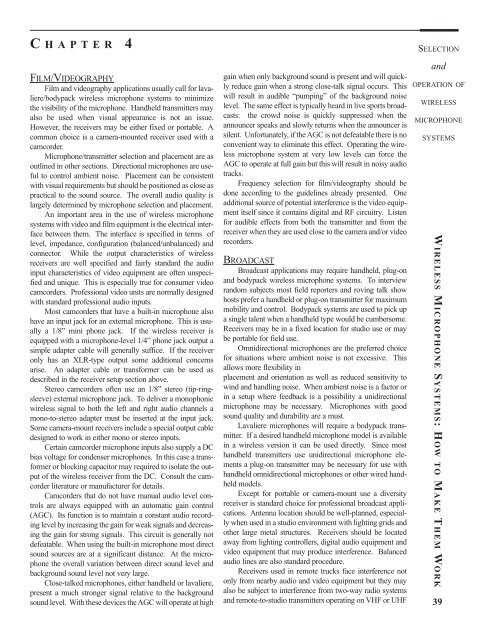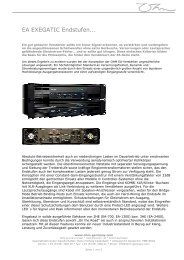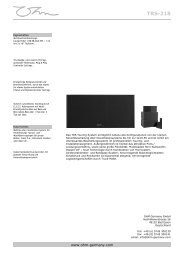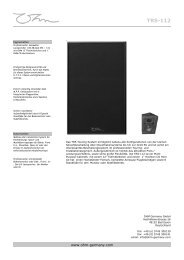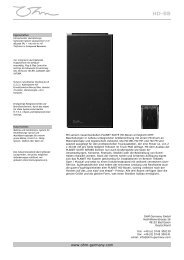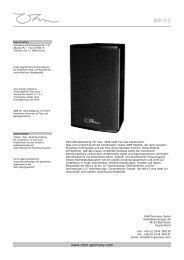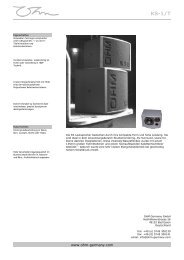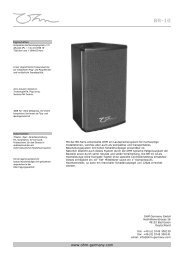Selection and Operation of Wireless Microphone ... - SLD Mediatec
Selection and Operation of Wireless Microphone ... - SLD Mediatec
Selection and Operation of Wireless Microphone ... - SLD Mediatec
You also want an ePaper? Increase the reach of your titles
YUMPU automatically turns print PDFs into web optimized ePapers that Google loves.
C HAPTER 4<br />
FILM/VIDEOGRAPHY<br />
Film <strong>and</strong> videography applications usually call for lavaliere/bodypack<br />
wireless microphone systems to minimize<br />
the visibility <strong>of</strong> the microphone. H<strong>and</strong>held transmitters may<br />
also be used when visual appearance is not an issue.<br />
However, the receivers may be either fixed or portable. A<br />
common choice is a camera-mounted receiver used with a<br />
camcorder.<br />
<strong>Microphone</strong>/transmitter selection <strong>and</strong> placement are as<br />
outlined in other sections. Directional microphones are useful<br />
to control ambient noise. Placement can be consistent<br />
with visual requirements but should be positioned as close as<br />
practical to the sound source. The overall audio quality is<br />
largely determined by microphone selection <strong>and</strong> placement.<br />
An important area in the use <strong>of</strong> wireless microphone<br />
systems with video <strong>and</strong> film equipment is the electrical interface<br />
between them. The interface is specified in terms <strong>of</strong><br />
level, impedance, configuration (balanced/unbalanced) <strong>and</strong><br />
connector. While the output characteristics <strong>of</strong> wireless<br />
receivers are well specified <strong>and</strong> fairly st<strong>and</strong>ard the audio<br />
input characteristics <strong>of</strong> video equipment are <strong>of</strong>ten unspecified<br />
<strong>and</strong> unique. This is especially true for consumer video<br />
camcorders. Pr<strong>of</strong>essional video units are normally designed<br />
with st<strong>and</strong>ard pr<strong>of</strong>essional audio inputs.<br />
Most camcorders that have a built-in microphone also<br />
have an input jack for an external microphone. This is usually<br />
a 1/8” mini phone jack. If the wireless receiver is<br />
equipped with a microphone-level 1/4” phone jack output a<br />
simple adapter cable will generally suffice. If the receiver<br />
only has an XLR-type output some additional concerns<br />
arise. An adapter cable or transformer can be used as<br />
described in the receiver setup section above.<br />
Stereo camcorders <strong>of</strong>ten use an 1/8” stereo (tip-ringsleeve)<br />
external microphone jack. To deliver a monophonic<br />
wireless signal to both the left <strong>and</strong> right audio channels a<br />
mono-to-stereo adapter must be inserted at the input jack.<br />
Some camera-mount receivers include a special output cable<br />
designed to work in either mono or stereo inputs.<br />
Certain camcorder microphone inputs also supply a DC<br />
bias voltage for condenser microphones. In this case a transformer<br />
or blocking capacitor may required to isolate the output<br />
<strong>of</strong> the wireless receiver from the DC. Consult the camcorder<br />
literature or manufacturer for details.<br />
Camcorders that do not have manual audio level controls<br />
are always equipped with an automatic gain control<br />
(AGC). Its function is to maintain a constant audio recording<br />
level by increasing the gain for weak signals <strong>and</strong> decreasing<br />
the gain for strong signals. This circuit is generally not<br />
defeatable. When using the built-in microphone most direct<br />
sound sources are at a significant distance. At the microphone<br />
the overall variation between direct sound level <strong>and</strong><br />
background sound level not very large.<br />
Close-talked microphones, either h<strong>and</strong>held or lavaliere,<br />
present a much stronger signal relative to the background<br />
sound level. With these devices the AGC will operate at high<br />
gain when only background sound is present <strong>and</strong> will quickly<br />
reduce gain when a strong close-talk signal occurs. This<br />
will result in audible “pumping” <strong>of</strong> the background noise<br />
level. The same effect is typically heard in live sports broadcasts:<br />
the crowd noise is quickly suppressed when the<br />
announcer speaks <strong>and</strong> slowly returns when the announcer is<br />
silent. Unfortunately, if the AGC is not defeatable there is no<br />
convenient way to eliminate this effect. Operating the wireless<br />
microphone system at very low levels can force the<br />
AGC to operate at full gain but this will result in noisy audio<br />
tracks.<br />
Frequency selection for film/videography should be<br />
done according to the guidelines already presented. One<br />
additional source <strong>of</strong> potential interference is the video equipment<br />
itself since it contains digital <strong>and</strong> RF circuitry. Listen<br />
for audible effects from both the transmitter <strong>and</strong> from the<br />
receiver when they are used close to the camera <strong>and</strong>/or video<br />
recorders.<br />
BROADCAST<br />
Broadcast applications may require h<strong>and</strong>held, plug-on<br />
<strong>and</strong> bodypack wireless microphone systems. To interview<br />
r<strong>and</strong>om subjects most field reporters <strong>and</strong> roving talk show<br />
hosts prefer a h<strong>and</strong>held or plug-on transmitter for maximum<br />
mobility <strong>and</strong> control. Bodypack systems are used to pick up<br />
a single talent when a h<strong>and</strong>held type would be cumbersome.<br />
Receivers may be in a fixed location for studio use or may<br />
be portable for field use.<br />
Omnidirectional microphones are the preferred choice<br />
for situations where ambient noise is not excessive. This<br />
allows more flexibility in<br />
placement <strong>and</strong> orientation as well as reduced sensitivity to<br />
wind <strong>and</strong> h<strong>and</strong>ling noise. When ambient noise is a factor or<br />
in a setup where feedback is a possibility a unidirectional<br />
microphone may be necessary. <strong>Microphone</strong>s with good<br />
sound quality <strong>and</strong> durability are a must.<br />
Lavaliere microphones will require a bodypack transmitter.<br />
If a desired h<strong>and</strong>held microphone model is available<br />
in a wireless version it can be used directly. Since most<br />
h<strong>and</strong>held transmitters use unidirectional microphone elements<br />
a plug-on transmitter may be necessary for use with<br />
h<strong>and</strong>held omnidirectional microphones or other wired h<strong>and</strong>held<br />
models.<br />
Except for portable or camera-mount use a diversity<br />
receiver is st<strong>and</strong>ard choice for pr<strong>of</strong>essional broadcast applications.<br />
Antenna location should be well-planned, especially<br />
when used in a studio environment with lighting grids <strong>and</strong><br />
other large metal structures. Receivers should be located<br />
away from lighting controllers, digital audio equipment <strong>and</strong><br />
video equipment that may produce interference. Balanced<br />
audio lines are also st<strong>and</strong>ard procedure.<br />
Receivers used in remote trucks face interference not<br />
only from nearby audio <strong>and</strong> video equipment but they may<br />
also be subject to interference from two-way radio systems<br />
<strong>and</strong> remote-to-studio transmitters operating on VHF or UHF<br />
SELECTION<br />
<strong>and</strong><br />
OPERATION OF<br />
WIRELESS<br />
MICROPHONE<br />
SYSTEMS<br />
W IRELESS M ICROPHONE S YSTEMS:HOW TO M AKE T HEM WORK<br />
39


